The Philips PML 9009 is the brand's flagship LCD television with Mini LED backlighting. It boasts impressive build quality, a stylish remote, and Philips' unique multicoloured Ambilight feature. In terms of picture quality, black levels and contrast could be improved—they don’t quite match the depth and vibrancy offered by similarly priced competitors. However, thanks to effective image algorithms, tonal quality remains satisfying. The screen’s relatively low brightness is well managed, and the inclusion of Dolby Vision provides a gateway to HDR content. The TV’s smooth colour transitions are noteworthy, surpassing some higher-end models. The PML 9009 truly excels in gaming performance, offering an experience that will please any gamer. Its motion-smoothing system also deserves praise, with two adjustable sliders allowing users to select their preferred smoothing level, making it a solid choice for sports viewing. Although the TitanOS operating system is still evolving and lacks a wide range of apps, the manufacturer is expected to address this over time.
- Matching (Score)
- Our verdict
- TV appearance
- Where to buy
- Contrast and black detail
- HDR effect quality
- Factory color reproduction
- Color reproduction after calibration
- Smoothness of tonal transitions
- Image scaling and smoothness of tonal transitions
- Blur and motion smoothness
- Console compatibility and gaming features
- Input lag
- Compatibility with PC
- Viewing angles
- TV efficiency during daytime
- Details about the matrix
- TV features
- Apps
- Playing files from USB
- Sound
Philips PML9009 / 9019 / 9059 vs Philips PUS8500
Direct compare
The Xtra / PML9019 / PML9059 / PML9009 / PML9049 / AMBILIGHT TV
PUS8500 / PUS8560 / PUS8510 / PUS8600

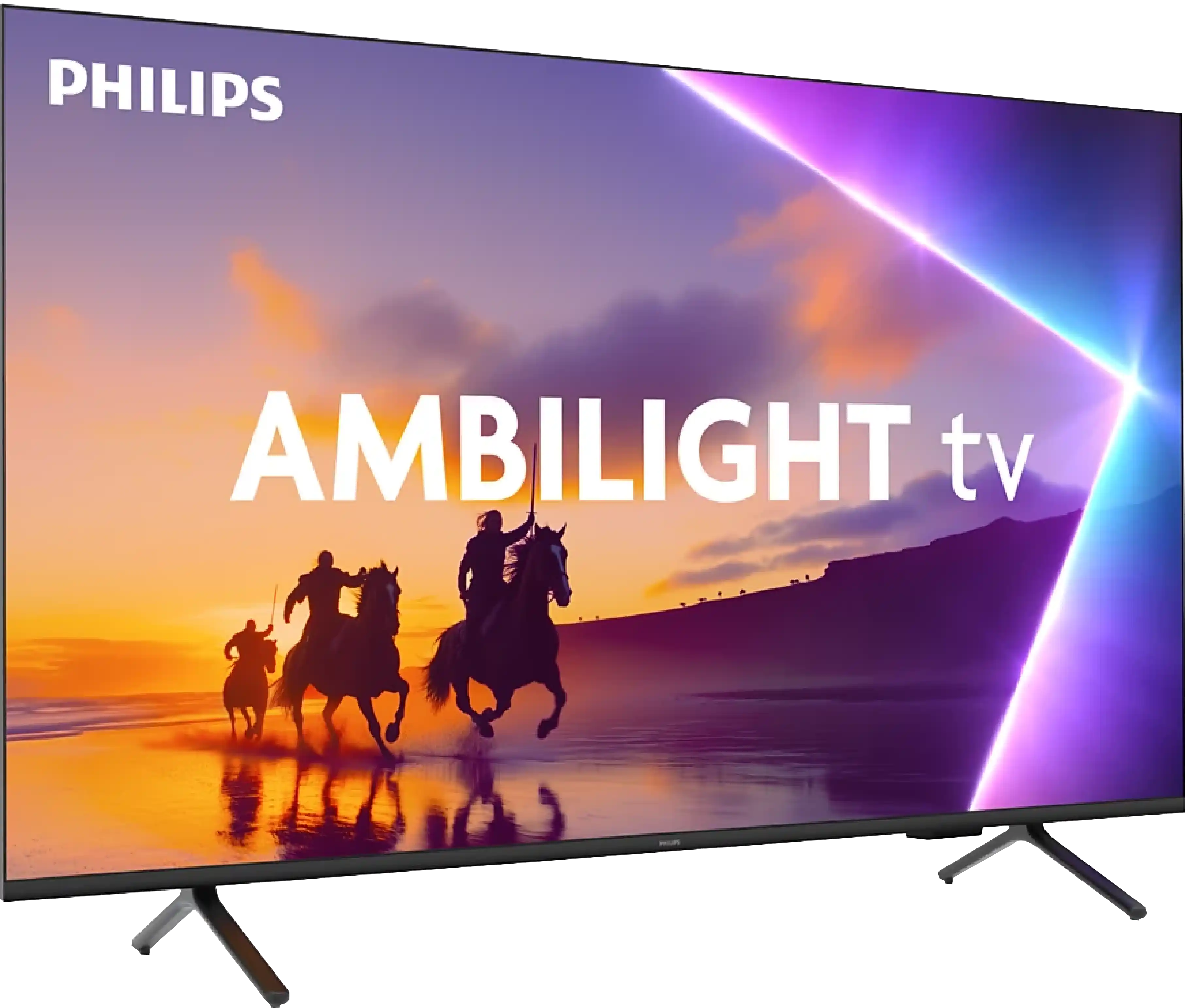
Panel type: LCD VA
Resolution: 3840x2160
System: Titan OS
Model year: 2024
Complete the survey to find out the result

Panel type: LCD VA
Resolution: 3840x2160
System: Titan OS
Model year: 2025
Complete the survey to find out the result

Overall rating
6.8
5.6
Movies and series in UHD quality
6.5
5.6
Classic TV, YouTube
6.3
6.2
Sports broadcasts (TV and apps)
6.6
5.2
Gaming on console
8.5
6.7
TV as a computer monitor
8.6
5.6
Watching in bright light
6.1
4.9
Utility functions
6.1
4.8
Apps
6.2
4.6
Sound quality
6.7
6.2
Complete the survey to find out what fits your preferences
Advantages
Superb tonal quality of scenes exceeding the capabilities of the television
Well-functioning dynamic tone mapping feature
Colour reproduction after calibration
Performance when connected to a console/PC
Ambilight TV System
High native contrast - VA panel
Low input lag
Basic features for gamers: ALLM and VRR
Full support for audio formats: Dolby Atmos and DTS
Backlit remote controler with numeric keypad
Disadvantages
Significant halo/bloom effect
Poor viewing angles
TitanOs system is not as advanced as the competition
Average contrast and black levels
Average panel brightness
TitanOS system feels unfinished (some features do not work, gaps in applications)
Infrared remote control
Font readability issues (PC)
Our verdict
Ambilight because that's where we have to start, it's the biggest reason to buy the PUS8500. The three-sided backlighting of the TV looks great, especially in the evening. It creates an atmosphere, masks the imperfections of contrast, and makes the viewing experience simply more enjoyable. Even if the black levels aren't perfect, the native VA panel's high contrast is just fine. On top of that, there's really decent input lag and several gaming features like ALLM and VRR. Although there’s no HDMI 2.1 or 120Hz panel, casual gaming should be a pleasure. Especially since it's responsive and latency-free. Additionally, there’s full support for audio formats – both Dolby Atmos and DTS, so soundbar owners can rejoice too.
But let's not kid ourselves – this is still a budget TV, and at times it shows. Brightness is average – not weak enough to make viewing impossible, but if you hit a particularly sunny day, watching conditions without blinds can be problematic. However, in our opinion, the biggest disappointment with the PUS8560 is the operating system, Titan OS. Despite the system debuting some time ago, certain features simply wouldn't work – for example, screen mirroring from a phone despite the manufacturer's claims that such a feature is present here. There are fewer apps than with competitors, and the system itself runs a bit clumsily. Overall, it seems to have some capabilities, but clearly lacks refinement.
Of course, this is not a TV meant to compete with top models. But if someone is looking for something simple, with a nice atmosphere that the Ambilight system provides, it is a quite reasonable offer. You just need to know what to expect and accept the many compromises present here.
TV appearance




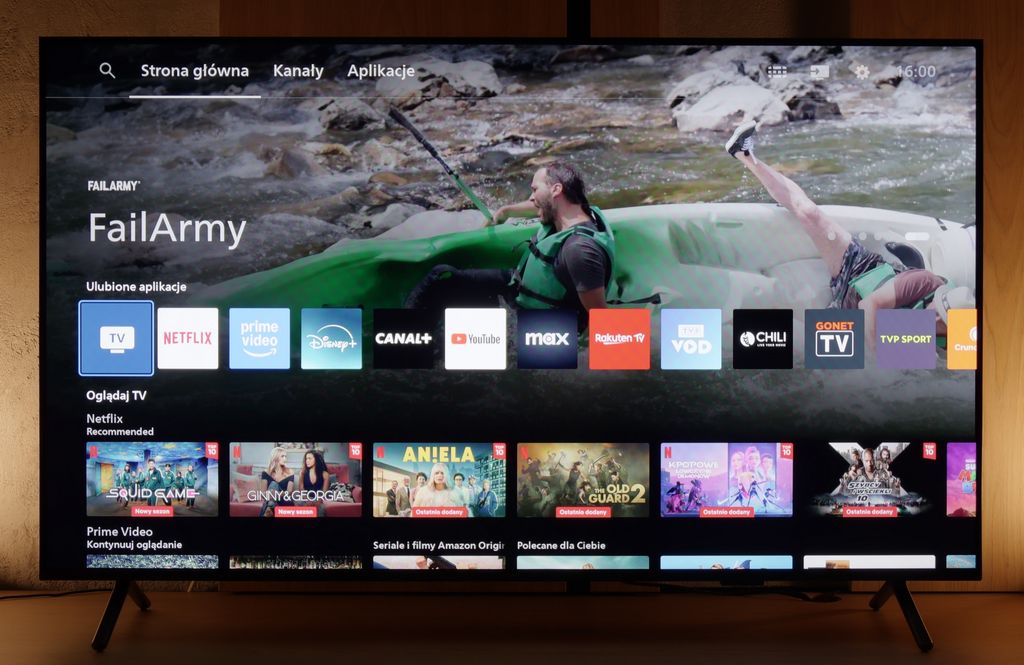
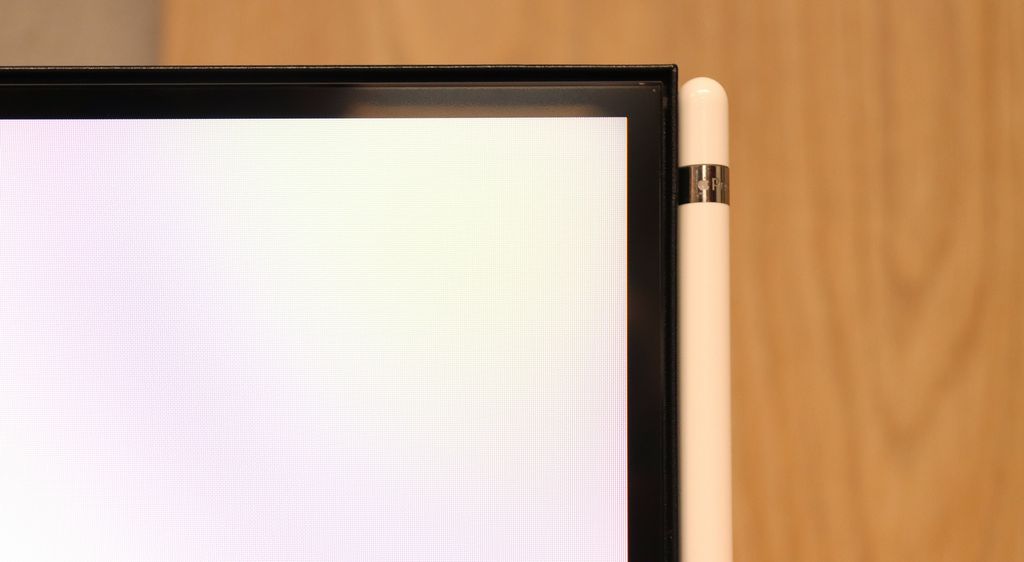
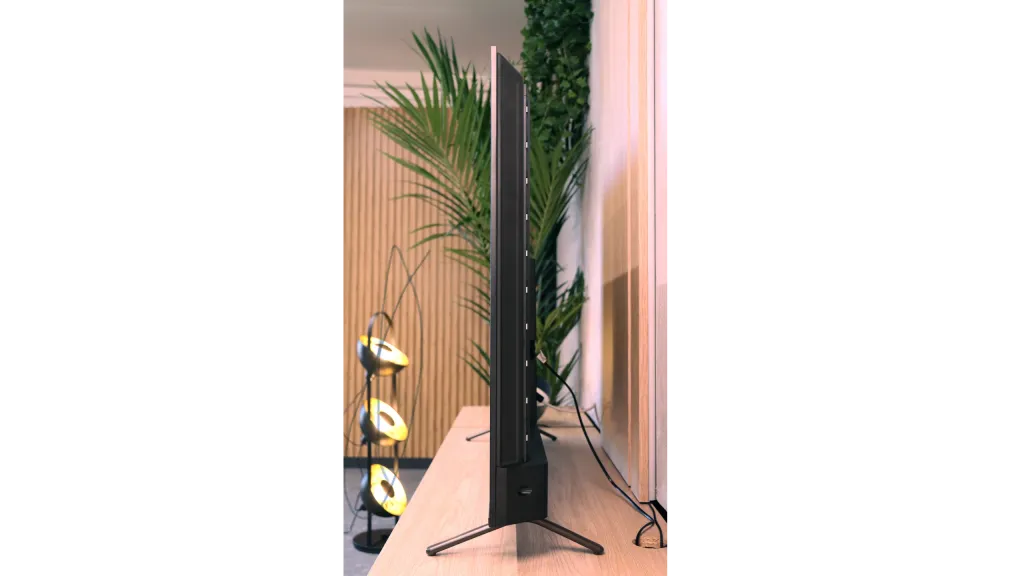
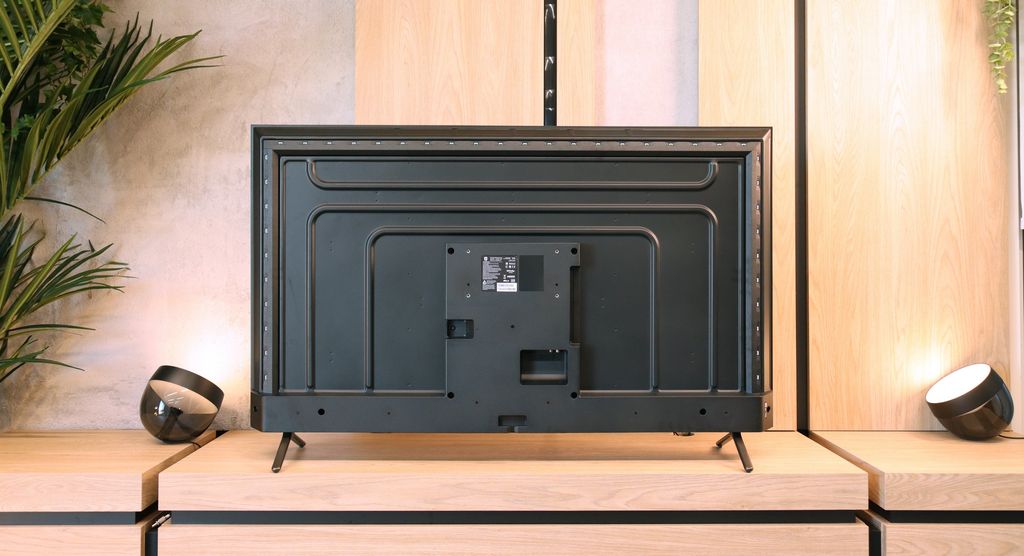
Contrast and black detail
6.6/10
6.1/10
Local dimming function: Yes, number of zones: 75 (15 x 5)
Local dimming function: No
Contrast:

Result
132,000:1

Result
16,550:1

Result
14,450:1

Result
7,850:1

Result
6,650:1

Result
6,000:1

Result
5,950:1

Result
6,250:1

Result
5,950:1

Result
5,750:1
Halo effect and black detail visibility:

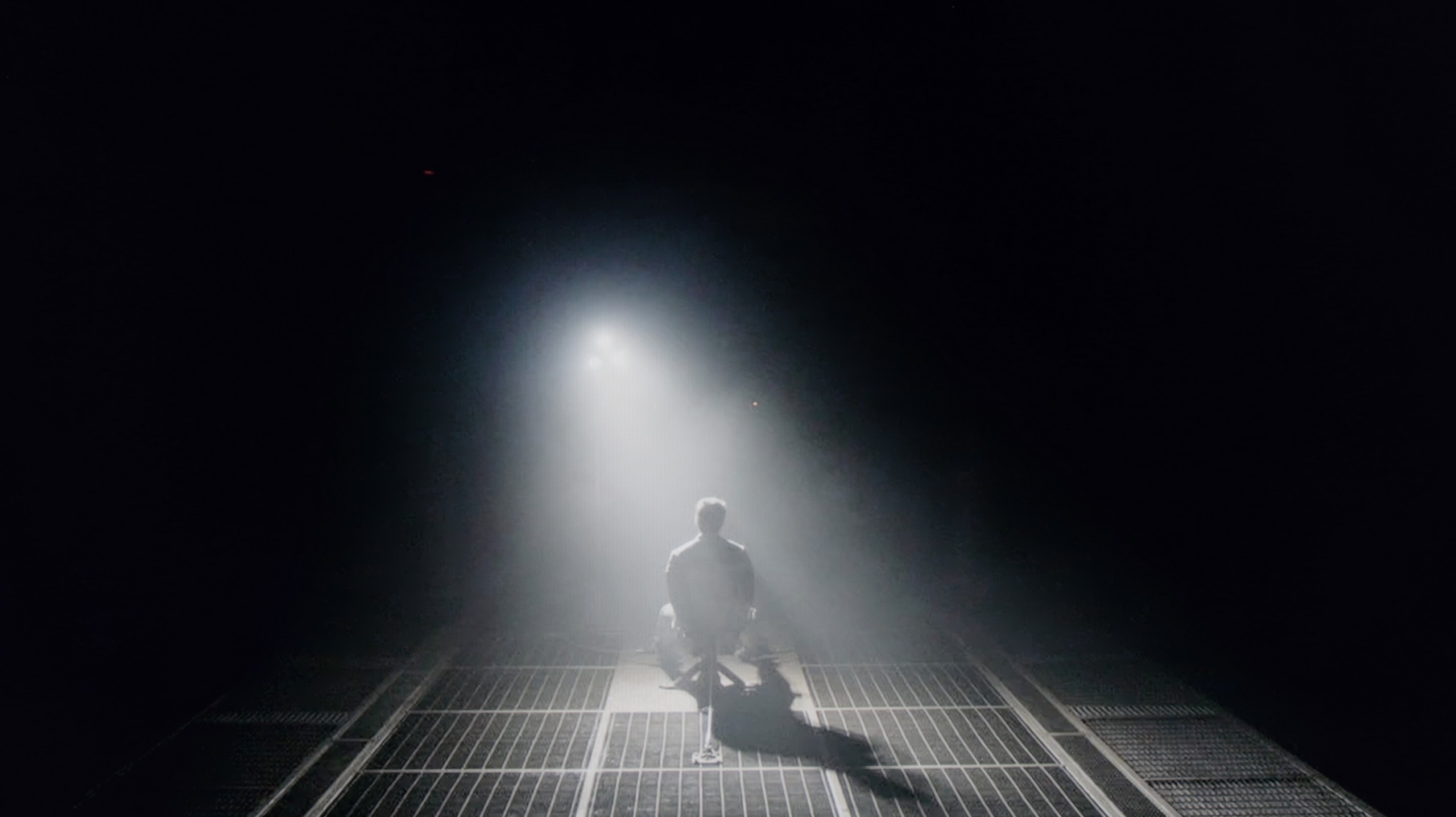
The Philips PML9009 features a high-contrast VA panel. While it doesn’t produce the same depth and dimensionality as OLED displays, it remains a solid choice for home cinema, outperforming IPS/ADS panels in this regard. The measured static contrast ratio, at 6000:1 without local dimming, is commendable and showcases the Mini LED backlighting capabilities of this model. Though the contrast and black level measurements aren’t among the highest, the television performed well in certain scenes, such as Oblivion, where it effectively separated light – an achievement not always seen in much pricier units. Testing was conducted at medium power dimming; the lowest dimming level didn’t achieve satisfactory black levels, while the highest setting led to detail loss. Unfortunately, our test with The Revenant highlighted some issues. While background details were clear, the dimming zones disrupted the overall tonal balance, resulting in a noticeable halo effect around the subtitles.
The Philips PUS8560 in the size we tested is equipped with a VA panel. As a result, the black levels – for an LCD television – can be considered decent. And that is exactly the case with this model. Both the blacks and the overall contrast impression in the film scenes we tested are quite good – the image does not wash out, and details are visible even in more difficult sections.
But the panel alone is not everything. Unfortunately, the PUS8500 is not equipped with local dimming (which is a given looking at the TV segment), so one has to reckon with the fact that with completely turned-off lights, the black can resemble more shades of navy than true black. On the other hand – and here’s a plus for Philips – the Ambilight system does a great job. The backlighting makes a real impact on contrast perception. Thanks to this, even if the black technically isn't perfect, the subjective viewing experience becomes much more enjoyable. For many people, that’s enough for an evening screening to be truly impressive.
HDR effect quality
6.1/10
4.8/10
Luminance measurements in HDR:

Result
548 nit

Result
550 nit

Result
824 nit

Result
491 nit

Result
582 nit

Result
273 nit

Result
300 nit

Result
324 nit

Result
343 nit

Result
334 nit
Scene from the movie “Pan” (about 2800 nits)


Scene from the movie “Billy Lynn” (about 1100 nits)


Static HDR10


Dynamic: Dolby Vision
Dynamic: HDR10+


HDR luminance chart:
Philips PUS8500
HDR luminance
Philips PML9009 / 9019 / 9059
HDR luminance
The Philips PML9009 struggles to deliver the highest HDR performance. Scenes with effects around 550 nits don’t provide particularly impressive lighting, though the effects remain stable, an improvement over SDR materials. A notable exception is in Gemini Man, where a flashlight as the sole light source stands out. This is likely due to the absence of large dark areas and the relatively small size of the light source compared to scenes with larger, brighter elements like the sun. While the brightness results in HDR content aren’t quite strong enough to recommend this TV for productions utilising a wide colour gamut, it’s worth mentioning that the model does achieve decent coverage, reaching 93% of the DCI-P3 spectrum.
When it comes to HDR performance on the PUS8560, one can confidently say that it is quite average. The brightness of the panel is around 350 nits, which we consider to be the absolute minimum for viewing content in this format. However, this is not a result that will impress viewers looking for the best possible image.
On the plus side, it is worth noting that the PUS8500 series – including the PUS8560/12 we tested – is marketed as a QLED television. And indeed, we can expect a wider color gamut here. This model is equipped with an additional filter (PFS), and the coverage of the DCI-P3 color space at around 90% should be sufficient for the majority of users. This filter works very similarly to quantum dots. As a result, the colors are quite well saturated. It’s not an outstanding result, but perfectly adequate for watching movies and series on streaming platforms.
Factory color reproduction
5.3/10
6.2/10


Factory Mode
After calibration
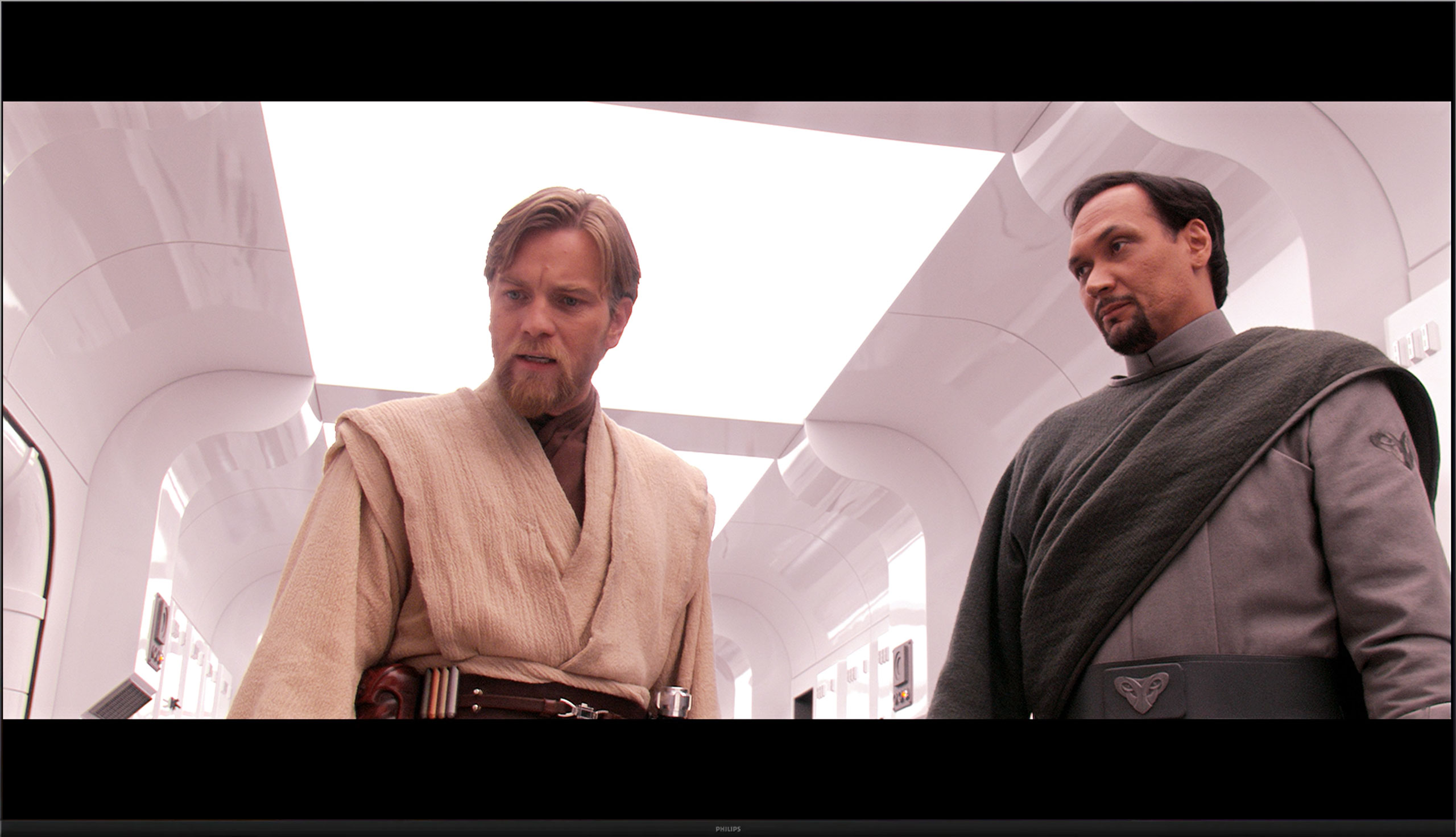

Factory Mode
After calibration
During testing, the Philips PML9009 performed best in the factory "Filmmaker" mode, which we evaluated across both SDR and HDR content. A key characteristic observed in this mode is the EOTF curve’s behaviour in HDR content and gamma settings in SDR, designed to enhance image accuracy. However, the PML9009 presented noticeable issues, particularly with white balance, as a pronounced red dominance created a yellow tint across the entire image. This affected skin tones and white areas, with faces and whites appearing unnaturally warm. The colour shift was confirmed through the "ColourChecker" palette, where colours leaned towards warmer shades.
In the gamma analysis, responsible for image contrast, we noticed considerable inaccuracies early on. Our measured values spiked above the reference, causing dark scenes to lose detail and merge visually up to about 10% screen brightness. Following this, the values dropped below the target line, further degrading contrast—an area already challenging for this model.
In HDR content, the white balance remained similarly flawed, and the EOTF curve also restricted brightness levels, resulting in a dim, muted image. Colour inaccuracies were even more pronounced here, with lower luminance levels causing large deviations from accurate colours, which were clearly visible on the error graph, often exceeding acceptable limits. While aiming for cinematic quality, this mode ultimately fell short in delivering balanced colour and contrast fidelity.
We tested the TV on the best available factory settings, which is in Film/Filmmaker mode – this is the mode we recommend for everyday viewing. Unfortunately, it is not without its flaws. Both in HD and HDR content, the image had a clear tendency to appear pinkish, caused by too much red and blue in the white balance. Another problem turned out to be excessive brightness of the image, which was confirmed by both the gamma chart and the EOTF curve. This characteristic was responsible for the loss of detail and washed-out colors in more challenging HDR scenes, as we mentioned earlier. Overall, this led to quite significant color reproduction errors – in extreme cases, the delta E value exceeded 7, while the threshold of visible errors for the human eye is about 3. This situation can be improved through calibration, and you can read about its effects below.
Color reproduction after calibration
7.5/10
8.4/10




Philips has long provided sophisticated calibration tools, including 2-point and 20-point grayscale adjustments as well as an advanced CMS (Colour Management System). These allow users to make significant improvements, and even those less attentive to image quality will likely notice a positive difference post-calibration. Both SDR and HDR content benefit from this process, notably eliminating the prominent yellow tint caused by an overemphasis on red in the white balance.
For SDR content, although gamma adjustments don’t entirely resolve the loss of detail in dark areas, the overall improvements bring most content to an impressive standard, with minimal, hardly perceptible errors. Colour accuracy is notably enhanced, achieving nearly reference quality with low deltaE errors.
HDR content, however, remains somewhat limited due to the display’s lower brightness capability. While the white balance has largely been corrected, a slight blue tint can occasionally appear. The EOTF curve aligns very well, providing accurate geometry, though colour errors persist due to the limited luminance. This calibration offers a substantial improvement but may still fall short for viewers who expect high brightness levels in HDR.
The Dutch manufacturer offers quite a large dose of settings in their products, so as usual, we decided to dig a little into them. The effects are immediately visible – we managed to correct the white balance, which made the image stop appearing excessively pink. The brightness characteristics were also partially balanced, of course, within the limits that the television itself allows. The image is no longer overly vibrant, and the overall reception after calibration is definitely better than in the factory settings of the Filmmaker mode.
One could only criticize the characteristics of the EOTF curve, which still indicates that the image tends to lighten materials in HDR format. Despite our efforts, the darkest parts of scenes can still be too bright, and the brightest do not always reach their full contrast potential. However, it must be clearly stated that we are dealing with a typically budget construction – you cannot expect reference-quality reproduction of HDR content from it.
Calibration definitely helped this model – it improved the balance, toned down the aggressive color scheme, and brought the image closer to what one might expect from a well-configured movie mode. However, there are certain limitations that cannot be overlooked.
Smoothness of tonal transitions
7/10
6.3/10





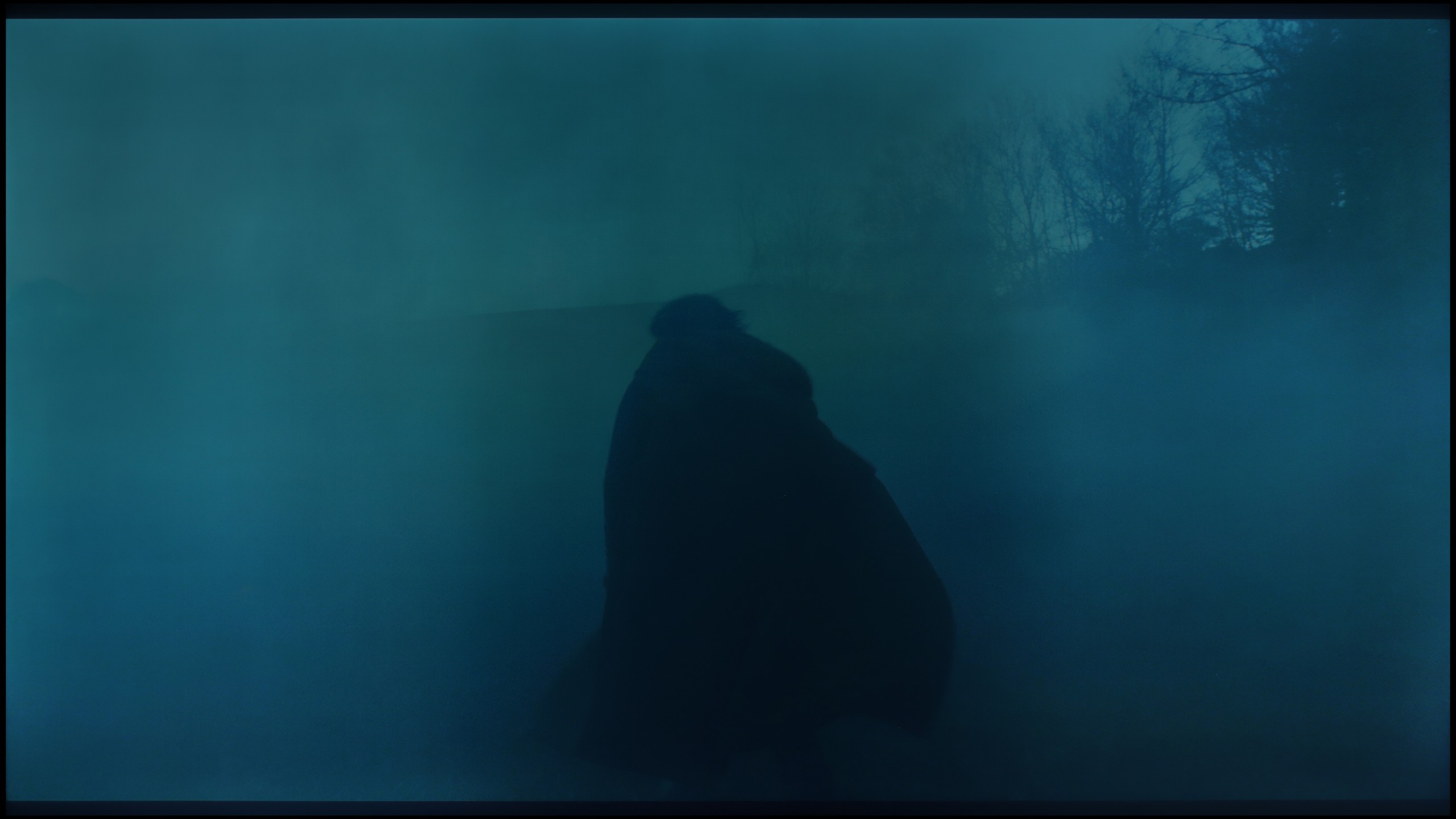

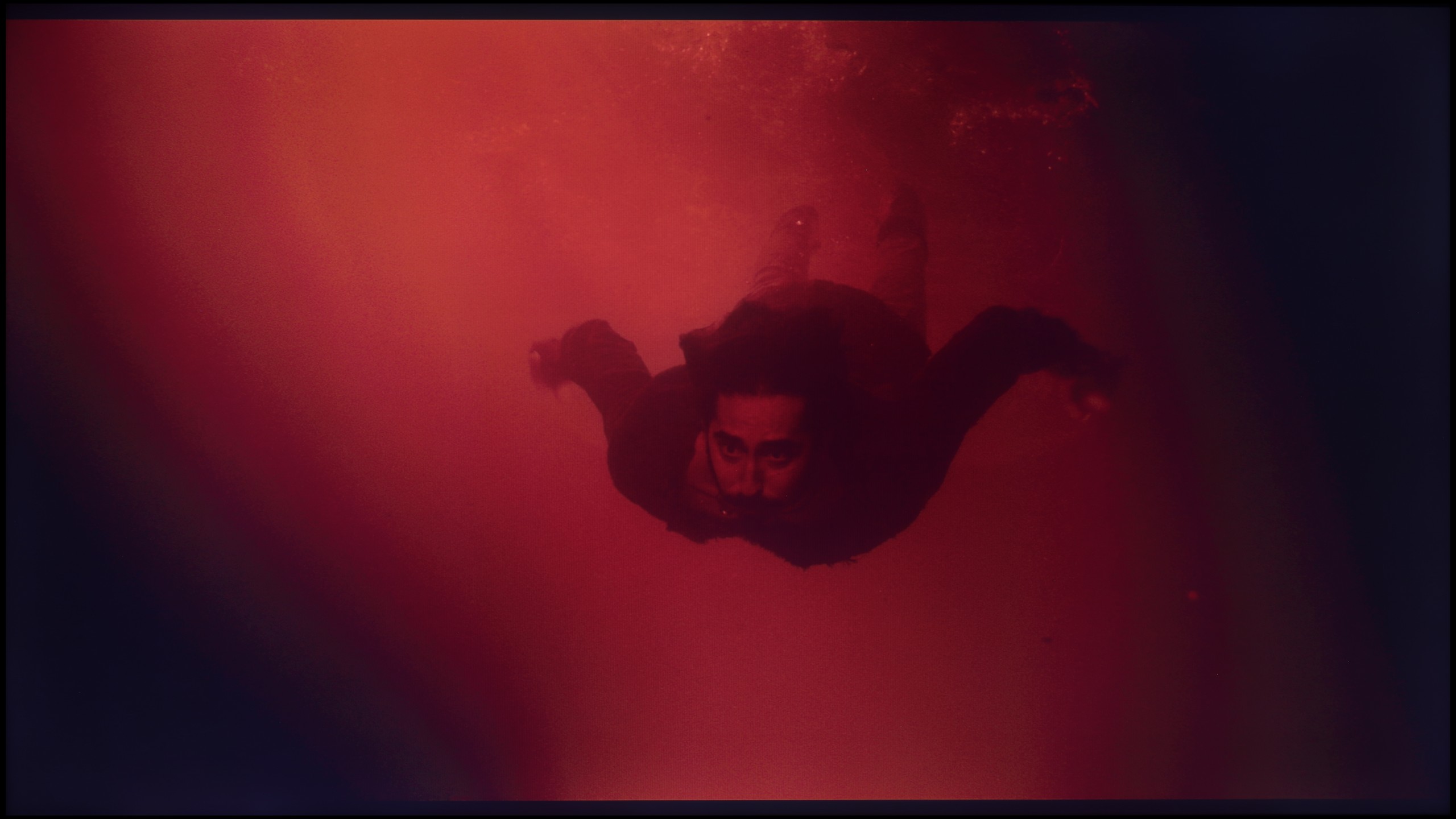




In many films or series, you may have noticed instances where colour bands appear in areas that should exhibit smooth transitions. This is why we evaluate tonal transitions as part of our testing. The Philips PML9009 performed admirably in this area across all test scenes. While a few elements could benefit from finer processing, the overall result was impressive. Notably, it handled the challenging scene from The Green Knight exceptionally well, with no significant stuttering or unwanted artefacts visible, proving the TV’s capability to maintain smooth gradients even in demanding scenes.
The PUS8560 handles color blending into smooth gradients very well. During testing, the image appeared cohesive and natural, with more serious issues with tonal transitions occurring only in very dark scenes – for example, in a shot with red water, where subtle cuts between colors could be seen. However, these are rather exceptions that do not spoil the reception of most content. It is worth mentioning another phenomenon that has a greater impact on image quality – the so-called dithering, or slight "sparkling" visible on solid backgrounds. This effect can be particularly noticeable in high-quality materials and may slightly detract from the impression of image clarity. It is for this flaw that we deducted some points in the rating.
Image scaling and smoothness of tonal transitions
7.2/10
6.1/10
Smooth transition function

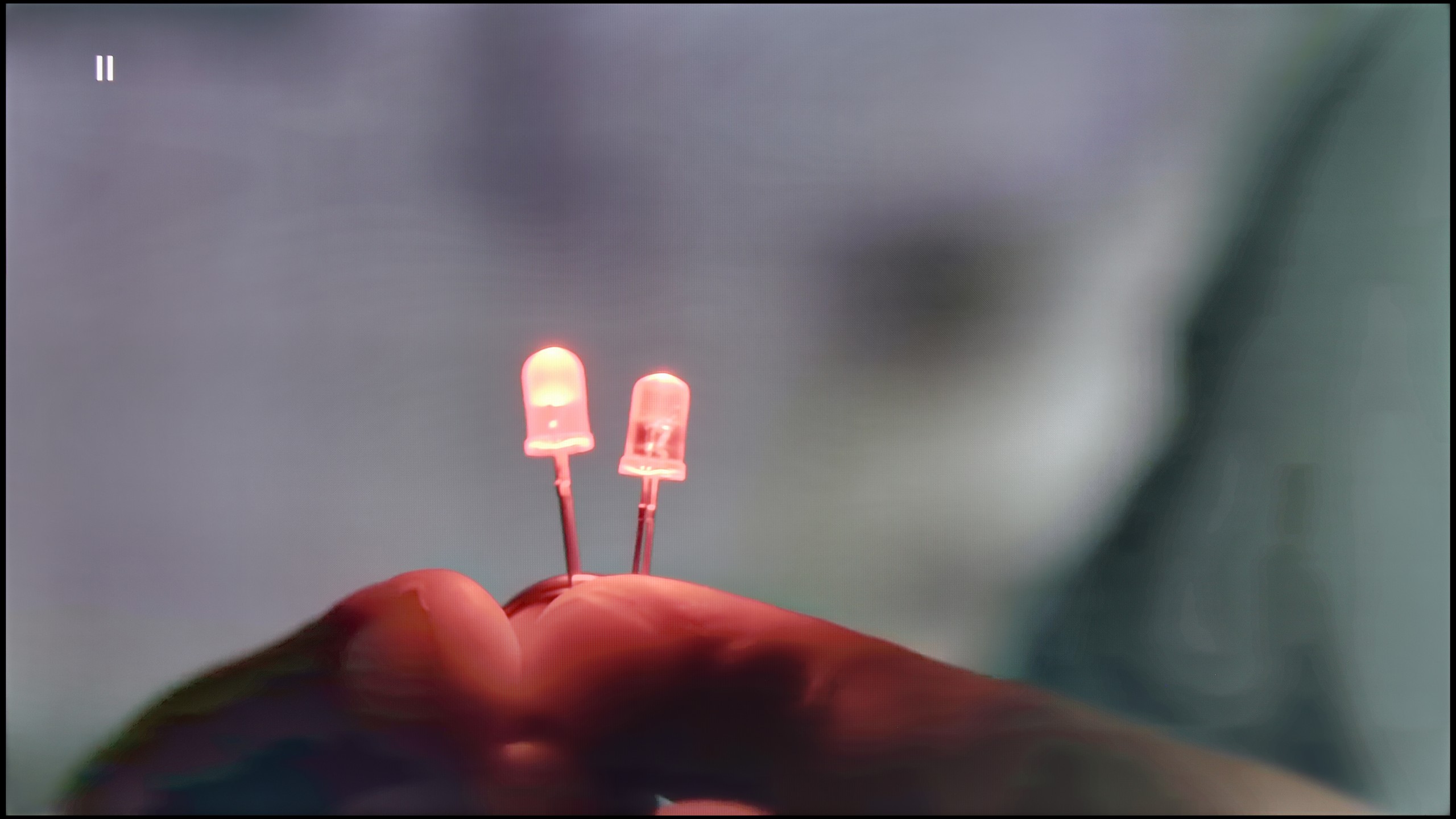
Image without overscan on the SD signal


Given the impressive handling of tonal transitions by the Philips PML9009, one might expect similar success in the image scaling test. However, the results were less than stellar. When upscaling lower-quality images, like those from certain TV programmes or older films, the Philips algorithm tended to blur fine details noticeably, especially in intricate elements like fine branches or a model's hair.
On the other hand, the tonal transition performance remains noteworthy, with the TV offering several levels of smoothing. Even at the lowest setting, it effectively addresses non-smooth transitions in most materials, and crucially, it preserves the film grain effect, maintaining fidelity to the director's vision. However, it’s worth noting that some fine details may still appear slightly softened.
Philips PUS8560 offers a feature that reduces posterization, hidden under the name "distortion reduction." And while it indeed serves its purpose by smoothing problematic tonal transitions, it operates a bit too broadly. In practice, it affects not only colorful gradients but also softens faces, clothing textures, and furniture surfaces. This decreases the authenticity of the image—especially in films where natural texture is of great importance. However, if someone is looking for smoothing at all costs, it's best to set this option to "Low." For cinema image enthusiasts—definitely not recommended.
On the plus side, the quality of upscaling older materials should be noted—the PUS8560 model handles them surprisingly well. The image maintains a natural softness without artificially enhanced sharpness. It is also worth mentioning that the television correctly displays very low-resolution content, avoiding problems with cropping the edges of the image (so-called overscan).
Blur and motion smoothness
7.7/10
4/10


Blur (native resolution, maximum refresh rate):






The Philips PML9009 has a 120 Hz native refresh rate, a baseline standard for watching sports and an ideal setting for gaming on consoles or PCs. Philips includes an effective motion-enhancement system for users who want to reduce the stutter of 24 fps content or need fluid motion for fast-paced scenes, like in football matches. The dedicated "Smoothness" slider effectively mitigates stuttering, while "Motion Blur Reduction" enhances the sharpness of dynamic content. Each setting produces a noticeable difference, so users can tailor the motion effects to their preferences. Our recommended setup achieves a moderate smoothing effect, avoiding the exaggerated “soap opera” appearance.
Regarding pixel response time, VA panels like this generally fall short compared to OLED or even IPS panels, which can lead to a slight "black halo" trailing behind fast-moving objects. Although not a frequent issue with this TV, the effect can be seen in certain scenes.
The Philips PUS8560 is a television equipped with a 60 Hz refresh rate panel, which already limits its capabilities for displaying dynamic content. Watching sports or playing on a console is not one of the most enjoyable experiences. The situation is further worsened by the lack of any option to improve the smoothness of films. In the menu, we won't find settings that would allow for the activation of a motion smoother or even a slight motion smoothing in films recorded at 24 frames per second. You can imagine the effect. The picture may look jerky, especially in shots with panoramic camera movements.
Console compatibility and gaming features
9.8/10
4.7/10
- ALLM
- VRR
- VRR range48 - 144Hz48 - 60Hz
- Dolby Vision Game Mode
- Correct implementation of HGIG
- 1080p@120Hz
- 1440p@120Hz
- 4K@120Hz
- Game bar

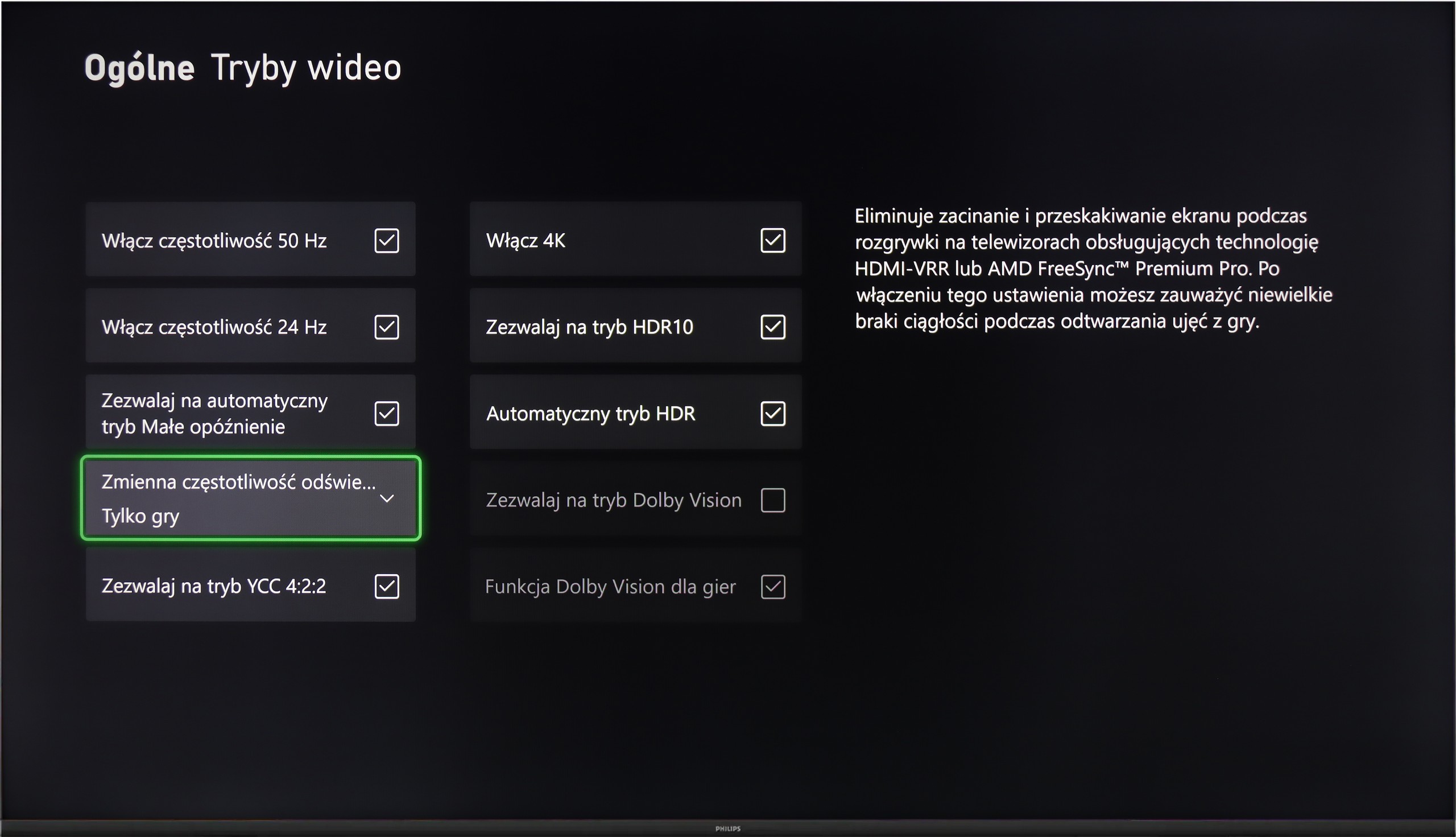

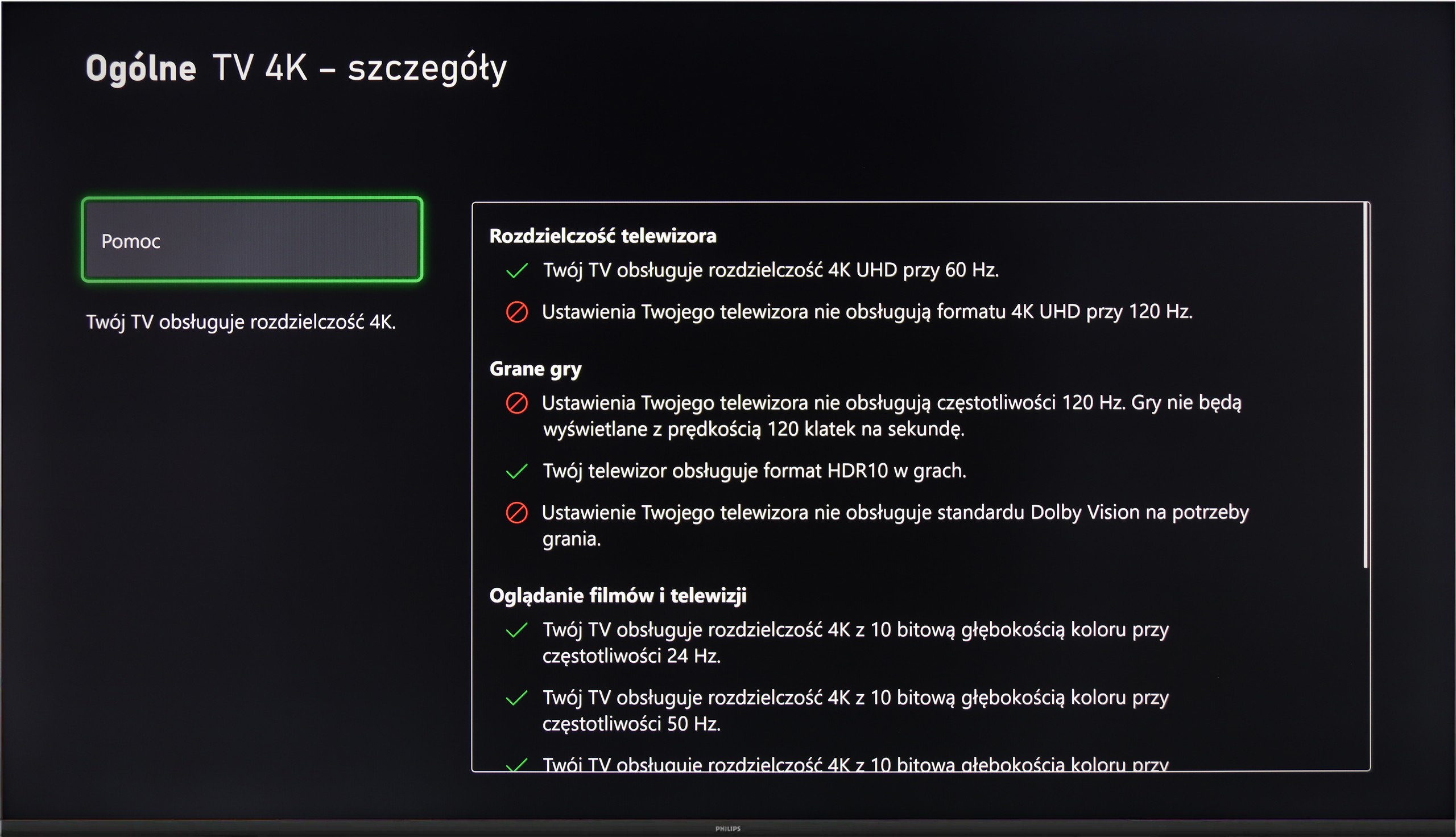

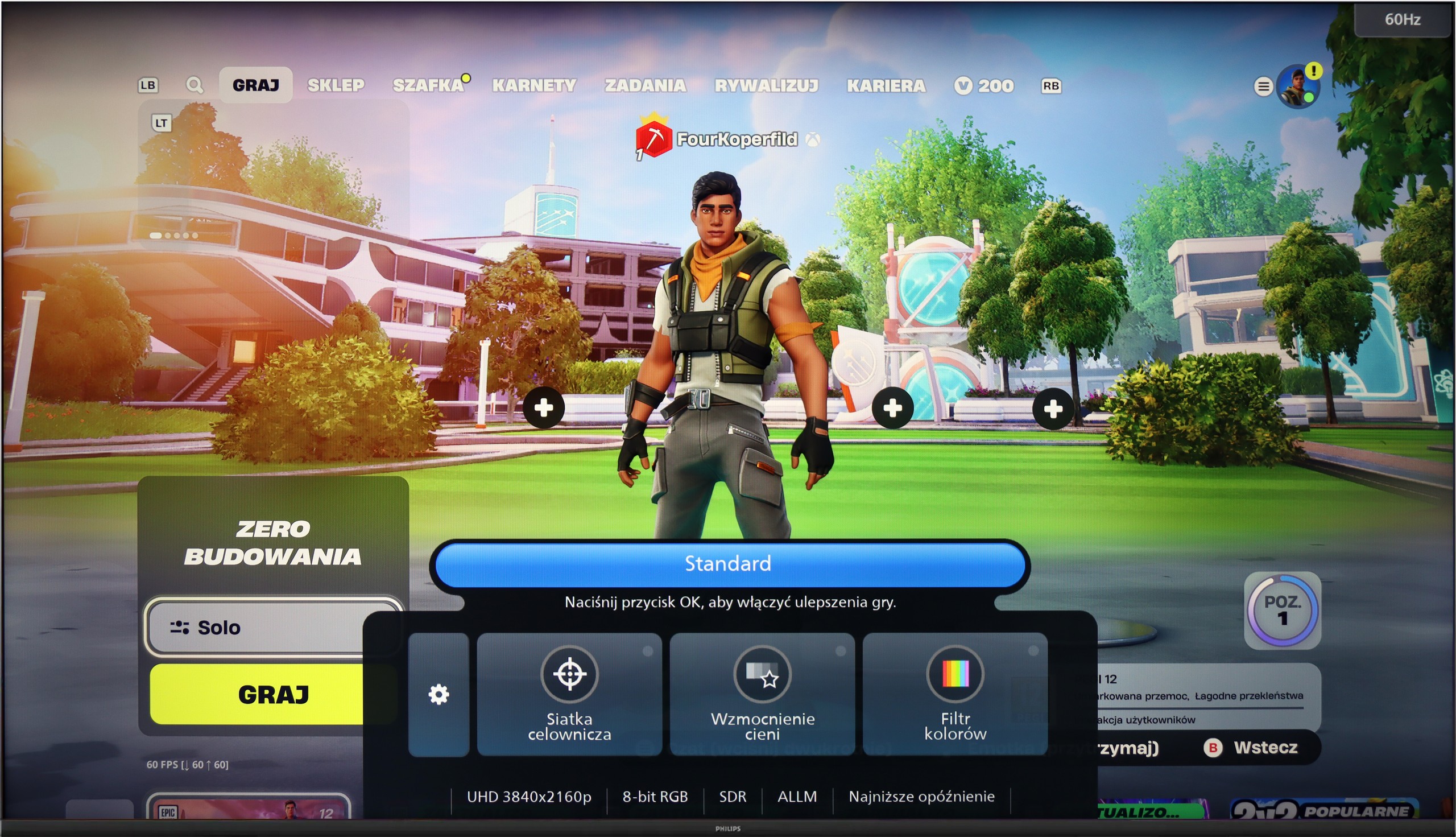

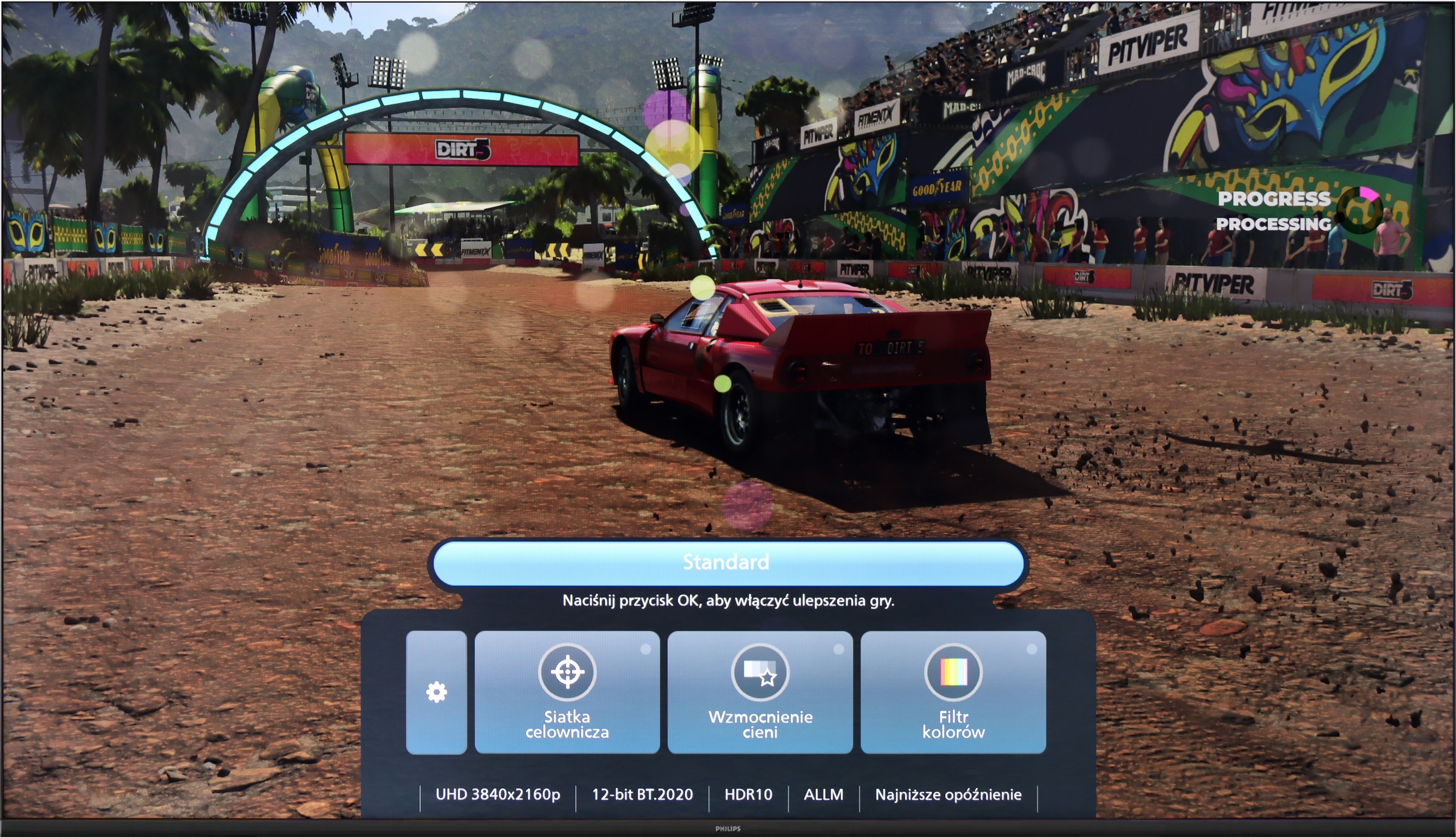
The Philips PML9009, with HDMI 2.1 ports supporting full bandwidth, is thoroughly equipped with gamer-focused features. Core functions like Variable Refresh Rate (VRR) and Auto Low Latency Mode (ALLM) are included, as well as the additional perks of G-Sync and FreeSync compatibility and low-lag HDR Dolby Vision support. All these gaming features activate seamlessly, proving this model’s suitability for gaming. The TV’s HGIG mode, particularly beneficial for gaming, adjusts HDR effects to the television’s capabilities to avoid image dimming and blooming, an advantage given the still limited number of games supporting Dolby Vision.
For added convenience, the PML9009 has a GameBar menu, allowing in-game setting adjustments without needing to exit. This menu includes features like a crosshair option and black level correction, which can enhance the visibility of shadowed areas—ideal for competitive play.
Overall, the Philips PML9009 offers a comprehensive setup for gamers, supporting VRR, ALLM, G-Sync, FreeSync, and HDR Dolby Vision to deliver immersive, high-quality gaming experiences across a wide range of titles.
Although the Philips PUS8560 is not designed specifically for gamers, the manufacturer decided to equip it with several features that may prove useful when connecting a console. It includes automatic switching to game mode (ALLM), as well as a simple connection status information bar – the so-called Game Bar. While it does not make a particularly strong visual impression, it serves its purpose. The presence of variable refresh rate (VRR), operating in the range of 48 to 60 Hz, might come as a surprise. While this is not a wide range, in the case of less demanding games or titles with unstable fluidity, VRR can help reduce the stuttering effect. However, this is the only element that can be considered above the minimum.
It should be clearly stated that the PUS8560 is not hardware for gamers looking for a responsive screen and full support for modern console features. It lacks HDMI 2.1 ports, the refresh rate is limited to 60 Hz, and the panel's response time is not among the fastest. This model may be suitable at most for casual gamers who want to enjoy the Ambilight system.
Input lag
9.6/10
10/10
SDR
HDR
Dolby Vision
The Philips PML9009 excels in input lag measurements, showcasing impressive performance across various signals and resolutions. Gamers will appreciate the manufacturer’s optimisation, with an exceptionally low input lag of 8 ms when playing at 4K120Hz with HDR—virtually imperceptible even in fast-paced online games. Furthermore, the game mode with Dolby Vision also maintains a commendable response time of 16 ms, ensuring that players experience minimal delay during gameplay. This combination of low input lag and effective game mode implementation solidifies the PML9009 as an excellent choice for competitive gamers seeking a responsive, immersive experience.
The input lag on the PUS8560 is very good. When we previously wrote that this screen is more for "casual gamers," there's no shame in this regard – even compared to screens aimed at gamers. Results around 12 ms are truly exceptional, allowing for enjoyable responsive gameplay. It doesn't matter if we are playing in Full HD or 4K – the lag remains just as low, so if you care about quick reaction times, the PUS8560 will definitely not disappoint in this aspect.
Compatibility with PC
8.6/10
5.6/10

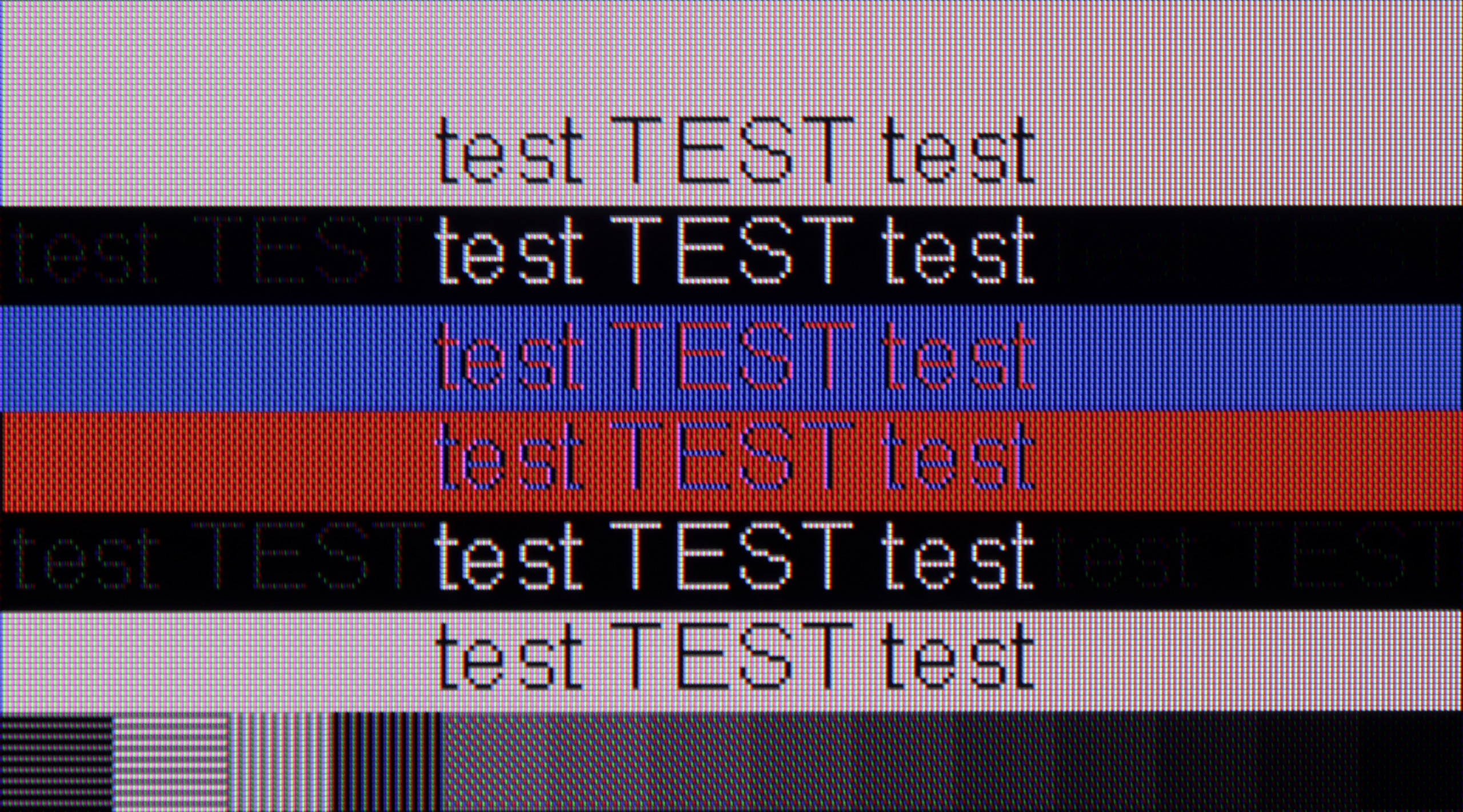
The Philips PML9009 also excels in everyday tasks, with measured delays of just 8 ms providing nearly instantaneous reactions in the mouse-screen-eye connection. Its proper implementation of chroma 4:4:4 ensures crisp, sharp fonts, making it ideal for text work. While the subpixel layout of the matrix is BGR, this doesn't create any issues when using the Windows operating system. However, users on other systems may encounter challenges with text rendering, as those platforms may struggle to convert text accurately. Overall, the PML9009 is a versatile display suitable for gaming and daily productivity tasks.
When it comes to working with a PC on the PUS8560, it looks... quite strange. Chroma 4:4:4 is present in "Monitor" mode, but there is a problem with gray fonts – not all subpixels light up, which makes the text appear pixelated. On the other hand, in "Game" mode, chroma 4:4:4 disappears, but the gray fonts look correct. In practice, we are therefore forced to juggle settings if we want to have perfectly readable text all the time. And what about gaming on the computer? Our opinion remains the same as regarding consoles – it's doable, but without any fireworks. There is no variable refresh rate for G-SYNC graphics cards, and the refresh rate itself remains relatively low. On the plus side, we can again highlight the very low input lag, which saves the day in fast-paced games.
Viewing angles
2.6/10
3.3/10
A commonly known drawback of VA panels that do not have an angle coating is their poor viewing angles. This is no different this time. Even after a slight shift off-axis, the image becomes washed out, and the colours undergo significant degradation.
The viewing angles on the PUS8560 are exactly what you would expect from a VA panel - they don't perform the best. The image loses quality even with a slight shift off-axis – colors become washed out, and the black starts to resemble a dark navy. This is, of course, the price paid for the better contrast that VA offers directly. In the case of our 55-inch unit, it is still acceptable, especially if the TV is perfectly positioned in front of the couch. But with larger screen sizes or a less central placement in the living room – it could be a problem for comfortable viewing.
TV efficiency during daytime
6.1/10
4.9/10

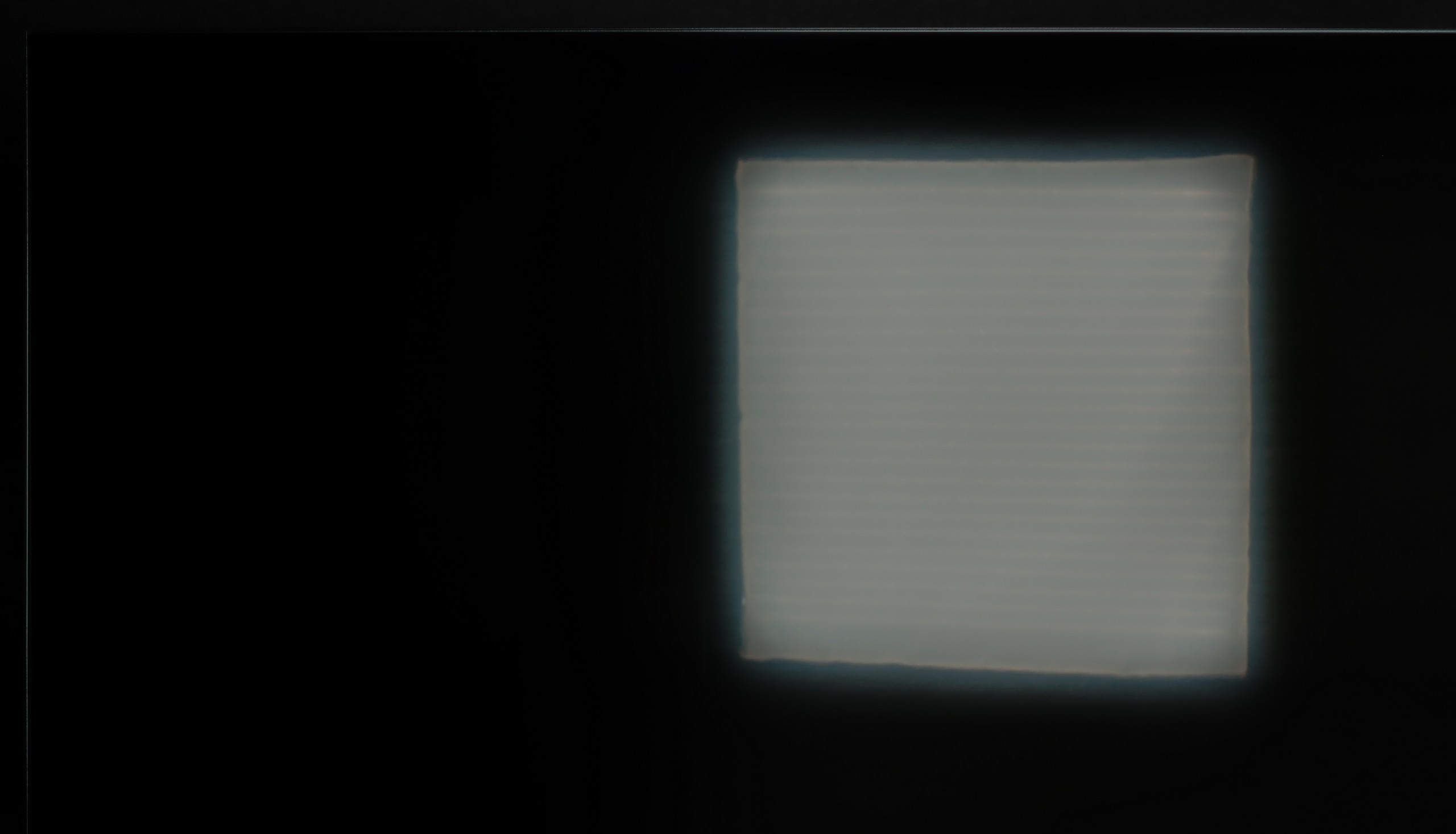


Matrix brightness
Average luminance SDR
Philips PUS8500 : 331 cd/m2
Philips PML9009 / 9019 / 9059: 564 cd/m2
While the Philips PML9009 offers good brightness levels for SDR materials—making it suitable for evening or dark-room viewing—the reflection suppression is only average. This can be attributed to the satin finish of the panel, which is prone to reflections from various light sources, as it neither absorbs nor diffuses them effectively. However, the relatively high brightness in SDR mode enables the television to perform adequately in brighter rooms, often outperforming many OLED models in this regard. This makes it a viable option for users who might watch content in well-lit environments.
PUS8560 performs moderately during the day. The satin finish of the panel effectively reduces reflections, so light from the window or lamp doesn't interfere too much. The black also looks decent for a VA panel – even in daylight, there are no significant losses in contrast. But the charm fades when it gets really bright. The panel's brightness is around 300 nits, which is definitely too little to speak of full comfort in a brightly lit room. In such conditions, the PUS8560 simply needs to be supported by curtains – otherwise, the picture starts to look quite pale.
Details about the matrix
Subpixel Structure:

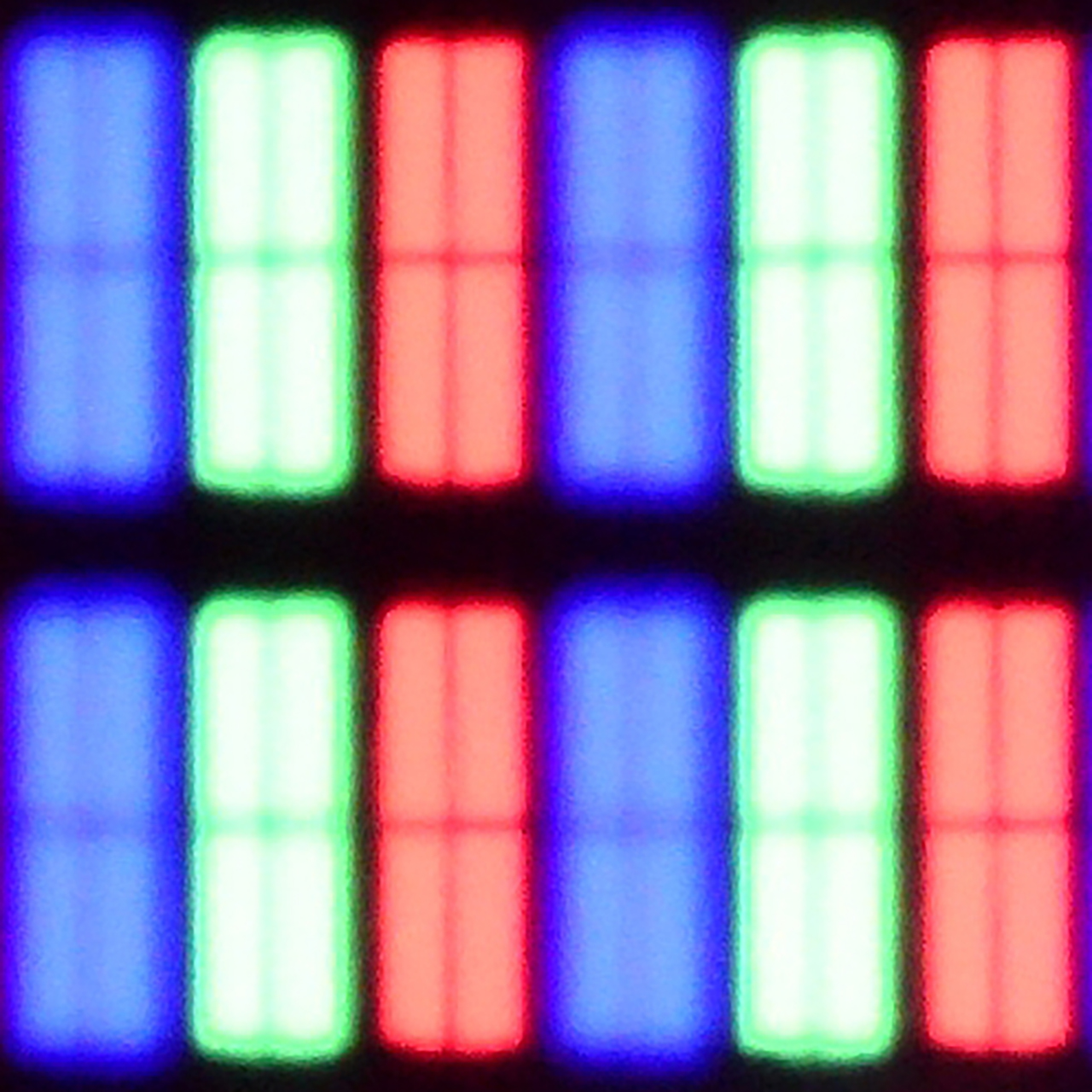
Panel uniformity and thermal imaging:


Philips PML9009 / 9019 / 9059
Philips PUS8500
TV features
6.1/10
4.8/10
- HDMI inputs0 x HDMI 2.0, 4 x HDMI 2.1 48Gbps3 x HDMI 2.0, 0 x HDMI 2.1
- OutputsToslink (Optical audio), eARC (HDMI), ARC (HDMI), Mini-Jack (Headphones)Toslink (Optical audio), eARC (HDMI), ARC (HDMI), Mini-Jack (Headphones)
- Network InterfacesWi-Fi 2.4GHz, Wi-Fi 5GHz, Ethernet (LAN) 100MbpsWi-Fi 2.4GHz, Wi-Fi 5GHz, Ethernet (LAN) 100Mbps
- TV receptionDVB-T, DVB-T2, DVB-S, DVB-S2, DVB-CDVB-T, DVB-T2, DVB-S, DVB-S2, DVB-C
Classic features:
- Recording to USB (terrestrial TV)
- Recording programming
- Picture in Picture (PiP)
- RF remote control (no need to aim at the screen)
- Backlit remote control
- Teletext
- Audio only mode
- Bluetooth headphones support
- Simultaneous Bluetooth headphones & TV audio
Smart features:
- AirPlay
- Screen mirroring (Windows Miracast)
- Voice search
- Voice search in native language
- Ability to connect a keyboard and mouse



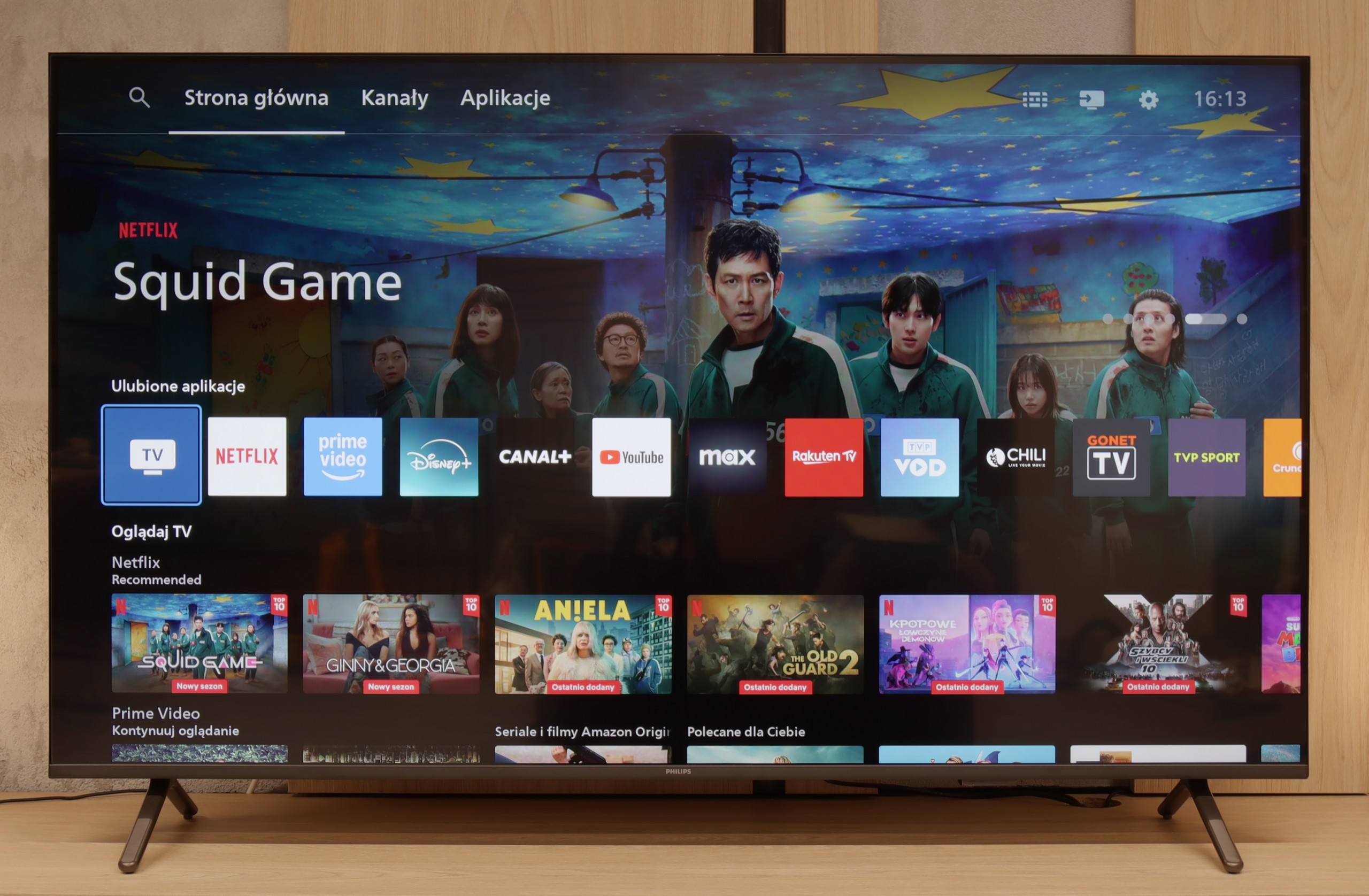
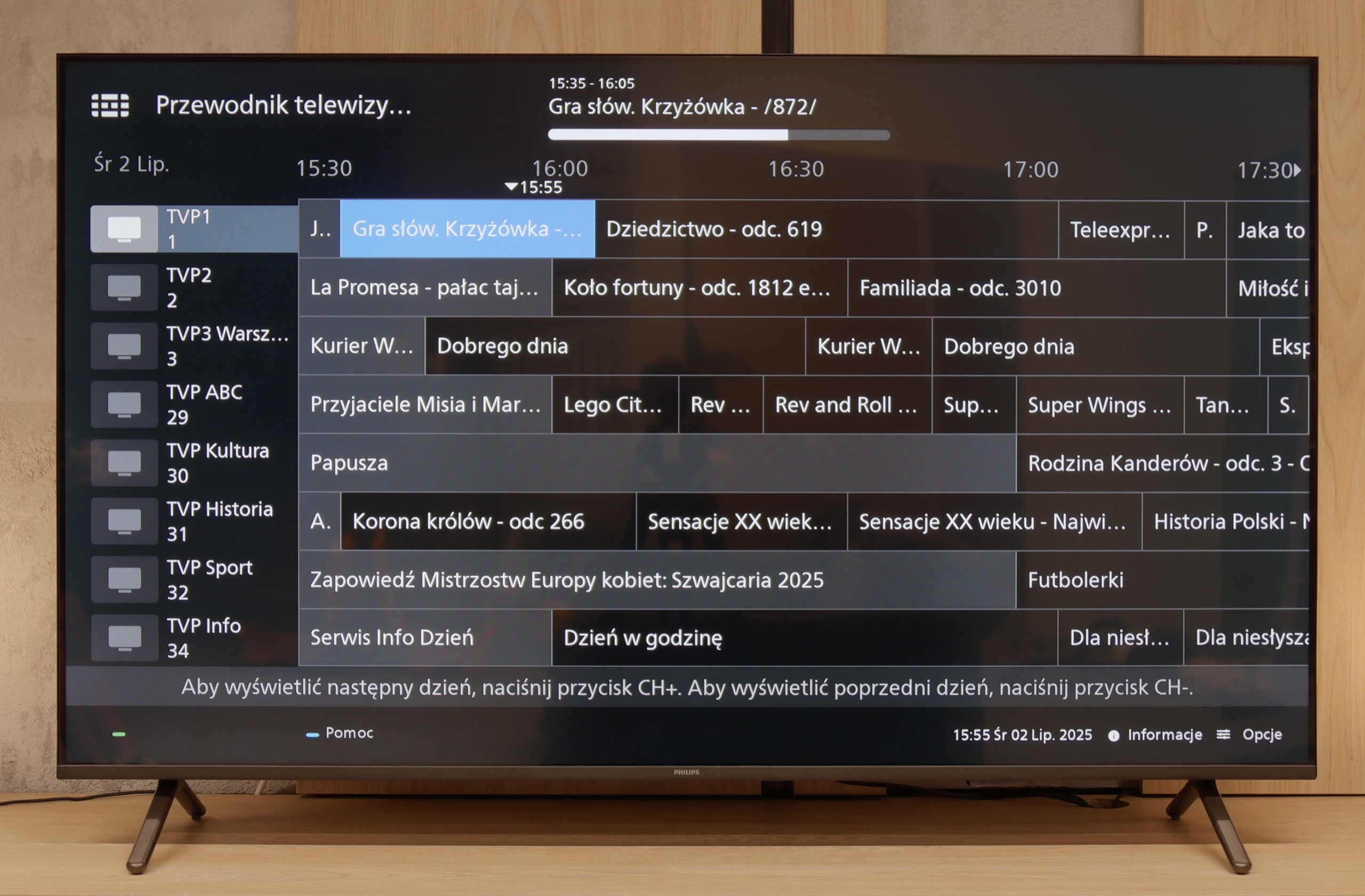
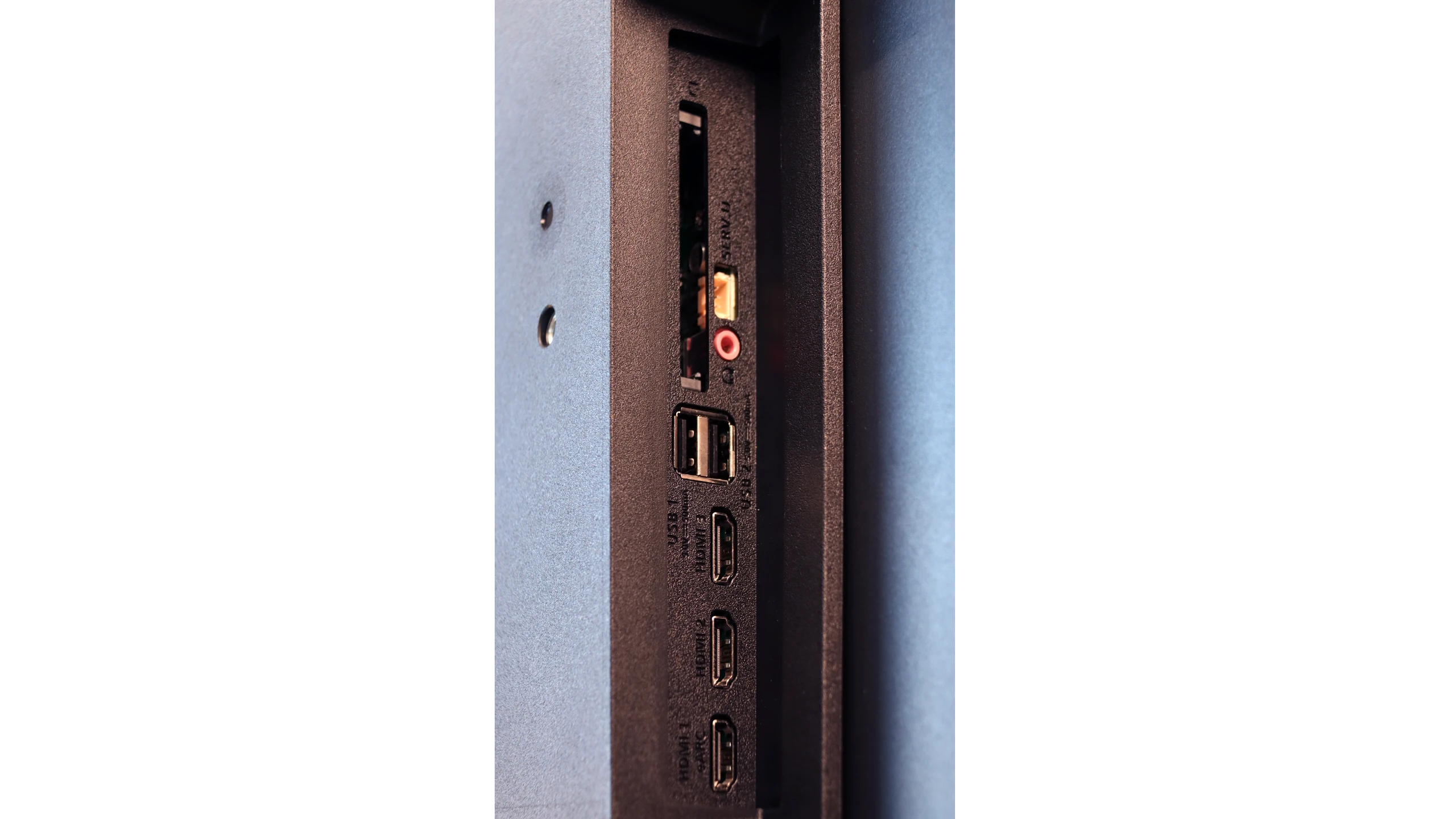
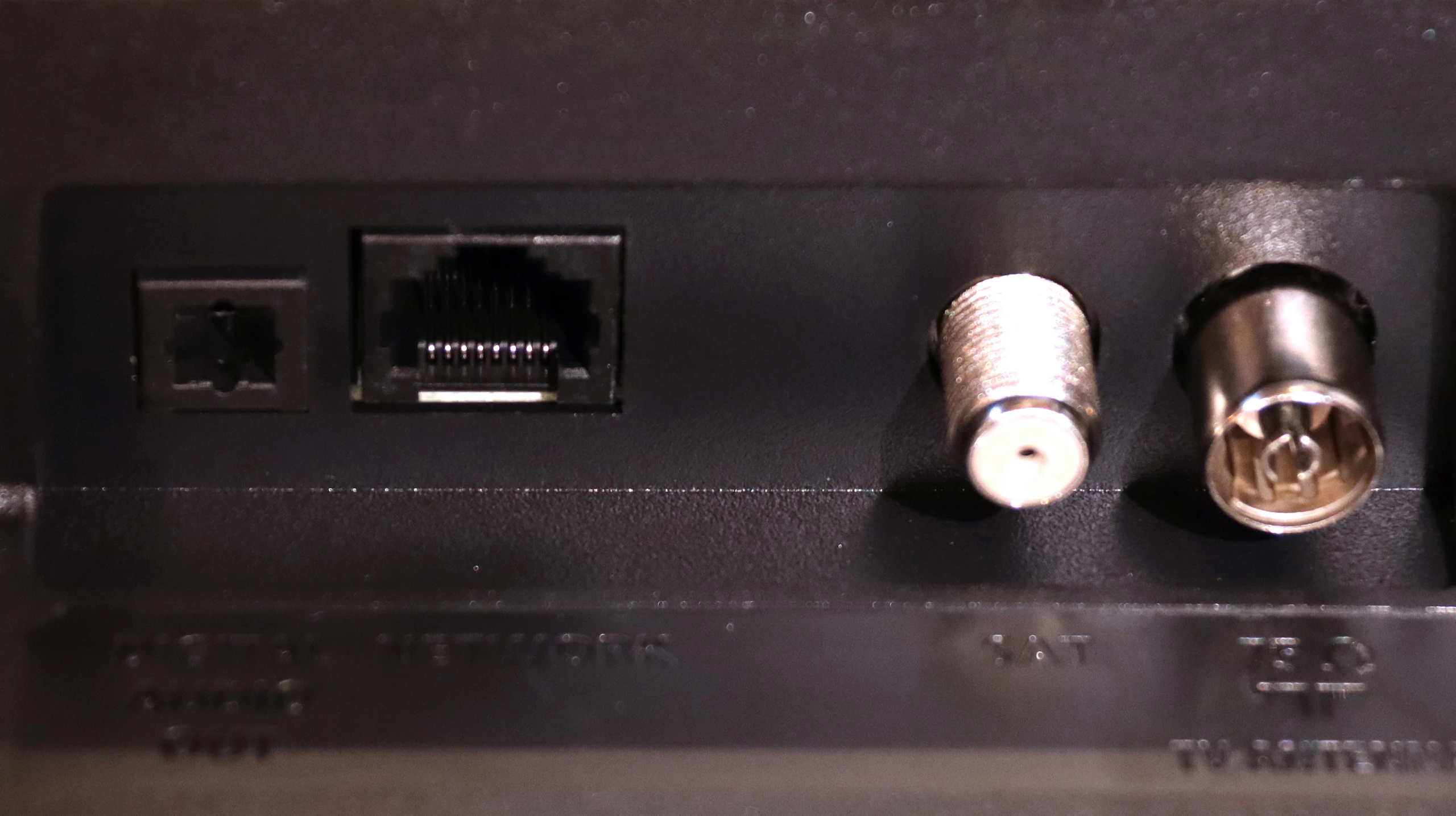
Before delving into the software that powers the Philips PML9009, it’s essential to highlight one of the standout features of the manufacturer’s TVs: the multicoloured Ambilight backlighting. This unique feature enhances the viewing experience by projecting colours from the back of the TV that correspond to the on-screen action, creating a more immersive atmosphere.
The operating system used in the PML9009 is Philips' proprietary TitanOs. While it offers some benefits, it is notably more closed and limited when compared to other models that use the Google TV system. One significant drawback is the absence of essential applications such as Apple TV, MAX, Canal+, and Player. Additionally, TitanOs restricts users from performing basic tasks like scheduling recordings or recording to USB. Apple device users may also be disappointed by the lack of AirPlay functionality, which allows for easy screen sharing.
On a positive note, the TV supports connecting a keyboard and mouse, which can simplify navigation through the menu. However, it's worth noting that while the remote pairs via Bluetooth for voice selection in English, all other functions rely on infrared (IR) connectivity.
In summary, TitanOs has its limitations, especially for users who frequently utilize a variety of streaming platforms. It seems better suited for those who primarily engage with a few key services—what one might refer to as the "holy trinity" of streaming: Netflix, YouTube, and CDA.
Classic TV Features:
If you are looking for a TV that "works" in the basic sense – the PUS8560 will serve that purpose. In terms of classic features, we have a rather minimalist set. On the plus side, it includes an electronic program guide (EPG), teletext, a backlit remote control with a classic numeric keypad, and a headphone jack. It sounds a bit like a dream set for seniors – and there is some truth to that. However, it must be said clearly: this is a TV with very limited capabilities. We won't find features for recording from DVB tuners to USB, nor is there a PiP mode or other conveniences known from more expensive models.
Smart TV:
How does SmartTV fare on the PUS8560? Well, this is where it gets a bit tricky. The PUS8560 runs on the Titan OS, which in this particular implementation caused significant problems. Some features, while present "on paper," simply did not work. For example: Wireless screen mirroring features like Chromecast or Miracast – we tried to activate them with several different phones and laptops… without success. Perhaps this will be fixed in the future, but at the time of testing – it did not work. Additionally, the system's speed left much to be desired – switching between apps or home screens was simply slow. A significant portion of the features in the menu feels heavily hidden in the depths of a poorly organized system. To make matters worse, the library of available applications is quite limited. While the situation with apps is better than last year, it is still far from ideal. The situation is somewhat saved by the modern remote – slim, elegant, and superbly made with a really great backlight. Unfortunately, it operates on classic infrared, so you have to point it at the screen. The only exception is the voice control, which works via Bluetooth… it's just a shame that it doesn't support Polish.
Playing files from USB
8.2/10
8/10
Supported photo formats:
Maximum photo resolution:

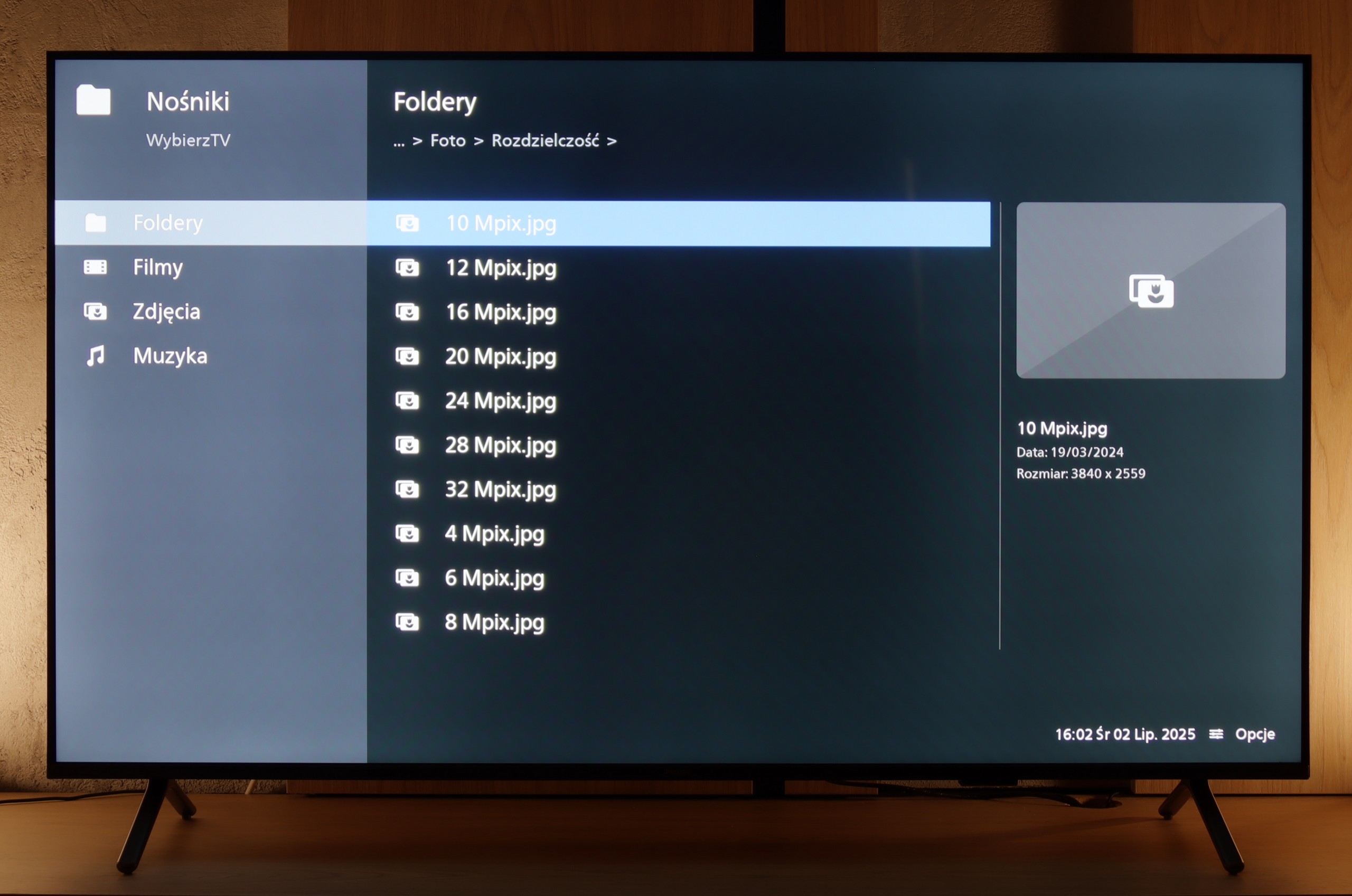
The default media player integrated into the Philips PML9009 provides a fairly comprehensive set of features but does have certain limitations. It supports nearly all common video formats except for the relatively rare .asf format. However, users may encounter issues due to the absence of the H.265 HEVC codec for high-bitrate content and a lack of support for .sub subtitle files, which are popular among many users.
With photo playback, the media player performs adequately, though it does not support some widely used resolutions and formats, such as HEIC, commonly found on Apple devices. The player excels in audio playback and leaves little room for criticism.
Unfortunately, the system's limitations prevent users from extending the player’s functionalities, meaning users are confined to the capabilities the manufacturer has included. This can be a drawback for those who rely on specific formats or additional features not provided by the built-in player.
PUS8560 handles playback of most popular video and audio formats from USB memory without any major issues, so there's no point in detailing the compatibilities individually. In daily use, it should just work – and it does. The only thing worth noting is the way it handles photos. Although the television easily recognizes common file extensions, with very high resolution graphic files, some photos may simply not display. This is not a huge problem, but it's good to keep it in mind, especially if we want to view photographs directly from the camera. Aside from that, PUS8560 shouldn't have any major problems with playback of files from USB.
Apps
6.2/10
4.6/10














































Sound
6.7/10
6.2/10
- Maximum volume--
- Dolby Digital Plus 7.1
- Dolby True HD 7.1
- Dolby Atmos in Dolby Digital Plus (JOC)
- Dolby Atmos in Dolby True HD
- DTS:X in DTS-HD MA
- DTS-HD Master Audio
At the outset, it is worth noting that sound quality is a subjective matter. The built-in audio system in the Philips PML9009 is characterised by clear high tones, but the bass is quite flat and significantly worse than in competing models in the same price range.
The TV sounds quite pleasant and it can confidently be stated that the sound level will be fully sufficient for most users – both for watching everyday programs and for an evening session with a series. Moreover, a nice surprise is that even in such an affordable series, Philips has decided to acquire licenses for full audio formats such as Dolby Atmos and DTS. This is great news for home theater and soundbar owners, as it means full compatibility and no need to "fiddle around" with connecting external devices.
